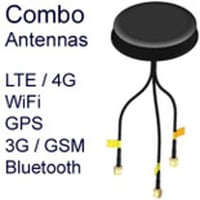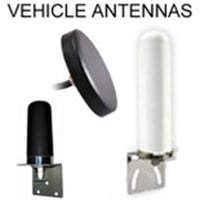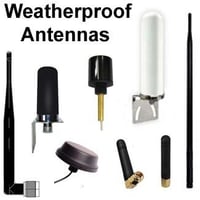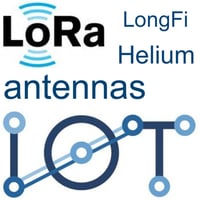LTE 4G 5G 3G GSM Cellular MultiBand Antennas
LTE Frequency Bands: Verizon, AT&T, T-Mobile and Sprint
|
Carrier |
Frequencies |
4G LTE Bands |
|
Verizon Wireless |
1900, 1700f, 700c |
2, 4, 13* |
|
AT & T |
1900, 1700 abcde, 700 bc |
2, 4, 5, 12, 17* |
|
Sprint |
1900 g, 850, 2500 |
25*, 26, 41 |
|
T-Mobile |
1900, 1700 def, 700 a, 600 |
2, 4*, 12*, 66, 71** |
Note: * are the primary 4G LTE Bands, while ** were rolled out in 2017.
Verizon Wireless
- Primary frequency is 700 MHz (band 13)
- Backup bands: 1700 and 1900 MHz (bands 2 and 4) in cities and urban areas.
- Verizon's 700 MHz spectrum enables the best and the most robust 4G LTE coverage in the U.S.
AT&T
- Primary band is 17 in most areas in the U.S.
- Uses: 2, 4, and 5 mostly just when band 17 is not available in a particular area.
Sprint
- Primary band is 1900 MHz (band 25)
- Uses 1600 MHz and 2500 MHz (bands 24 and 41) as contingencies, typically when band 25 is not providing the desired fast data speed to users.
T-Mobile
- Primary frequency is 1700 MHz (band 4)
- In areas where band 4 is not reliable: Uses 700 MHz, 1700 MHz, 1900 MHz (bands 2, 12, and 66).
- Using 600 MHz (band 71) in the following rural regions: Eastern Washington, Central Virginia, Central Pennsylvania, Coastal North Carolina, Maine, Western North Dakota, Southwest Kansas, West Texas, Northwest Oregon, and Wyoming. With this new bandwidth, more than 6 million Americans will enjoy uninterrupted fast data across these regions.
- Won the 300 MHz auction: 300 MHz increased its market share in the market.
- After Verizon Wireless, T-Mobile is arguably the largest 4G LTE network in the U.S.
LTE (4G), GSM (3G & 2G), CDMA (3G & 2G), and ISM explained
- LTE is 4G: The technology that connects are latest generation of Smartphones with broadband internet and VOIP.
- GSM was a rival standard for 2G, that is used in most of the world
- WCDMA and HSPA are the follow-on technology for 3G. In the US, most people still call it GSM.
- CDMA is a 2G & 3G Verizon standard used in the United States and a few other places
- 4G is broadband-speed internet on Smartphones, with VoIP.
- 3G was voice + reasonably good data. 3G was the first generation of smartphones.
- 2G was voice cell phones (flip phones).
- ISM is reserved for medical, scientific and industrial use and not intended for public telecommunication.
What are cellular multi-band antennas?
Cellular multi-band antennas are antennas that can operate across several frequency bands used by the leading cellular networks. These external antennas are able to be used with a variety of devices to provide cellular connectivity and support a range of applications and can be installed securely on fixed or mobile structures.
Because these are multi-band antennas, they can operate with several cellular providers and multiple geographic territories across the globe. This makes multi-band antennas ideal for roaming. Cellular antennas typically span frequencies used by 2G, 3G, 4G, and LTE technologies meaning that the connected device can switch between these cellular technologies to find the most reliable signal and performance if the desired carrier is unavailable.
These versatile antennas usually connect to devices via an SMA connector, which is routinely used in cellular networking applications. As cellular technology has diversified in its applications, the need for multi-band antennas in a variety of types and formats has increased.
Multiband antennas have a composite structure
To support cellular connectivity across a range of frequency bands these antennas are comprised of multiple antenna elements. The antenna elements vary in specification with some being ultra-wideband, others narrowband, directional or omnidirectional. This is a similar arrangement to combination antennas or certain vehicle antennas that serve several technologies.
Elements that are resonant across key frequencies are combined to provide the frequency coverage required. Additional elements are added to support MIMO connectivity.
The antenna elements used may have different formats including loops, folded, coils, wires, and ceramic or PCB elements. Individual antenna elements are isolated from each other to prevent interference.
The elements are housed in a single plastic radome which is filled with polyurethane foam. Both the plastic and the foam are fully permeable to the cellular radio frequency signals. Other components within multi-band antennas include feeding pads, grounding pads, fixing pads, ground planes.
Because multiple elements are used the antenna gain for individual frequencies may be reduced in comparison to an individual external cellular antenna for a specific frequency, however, the utility of the multi-band antenna cannot be denied.
Key types of cellular multi-band antennas.
-
Multi-band Yagi antennas for cellular communication
The Yagi-Uda antenna is a highly directional antenna that can be used to create strong point-to-point links with cell towers, especially in remote locations. This high-gain antenna is made of an array of multiple parallel elements. These are usually metal roads operating as half-wave dipoles. One of the elements is driven, being attached to a feedline, while the other elements are parasitic. These antennas may also include reflector elements and may be housed in a radome that hides its distinctive appearance.
-
Cellular multi-band collinear antenna
Collinear antennas are tall, composite antennas that consist of an array of dipole or quarter-wave elements. The multi-band elements are mounted vertically one on top of the other. The array is housed in a robust, weatherproof fiberglass radome with its connector at its base.
These antennas are high-gain, omnidirectional with vertical polarization. By stacking the antenna elements the maximum power is radiated on the horizontal plane and the minimum power vertically.
-
Multi-band puck antennas for cellular networking
Puck antennas are named because they resemble a hockey puck. There are rugged, weatherproof through-hole mount antennas that are often mounted on vehicles, particularly those used by the emergency services.
-
Articulating multi-band cellular antennas
Articulating antennas are ground plane independent antennas that carry an articulating knuckle that allows the antenna to be precisely angled through 0-90° for optimal positioning.
The cellular networking technologies that are served by cellular multi-band antennas include:
[A] 2G cellular networking.
Second-generation (2G) cellular networking is the earliest form of digital switch cellular networking which superseded analog cellular technology in the early 1990s. The first globally implemented 2G standard was the Global System for Mobile Communications (GSM), which achieved peak coverage in 193 countries and still has legacy infrastructure remaining to the present day.
2G distinguished itself from earlier cellular networking through the following notable features:
-
Digital encryption of phone calls between the end-user phone and cellular base station used. This represented a significant uplift in security.
-
Enhanced spectral efficiency allowing more users to use the available frequency bands.
-
The use of a Subscriber Identity Module (SIM) card, containing user information and contacts that can be exchanged between end-user devices.
-
SMS text messaging
-
Transfer of data packets using either Enhanced Data Rates for GSM Evolution (EDGE) or the General Packet Radio Service (GPRS).
GSM has been mostly overtaken by the more recent cellular networking technologies but is still relied on in certain regions and remote areas. This makes GSM frequency bands in multi-band antennas a useful backup for connectivity where 3G or 4G/LTE connectivity is unavailable, or while roaming.
[B] 3G cellular networking.
Third-generation cellular networking was developed using the 2G infrastructure and technologies. It is the cellular technology of the 2000s. The development and implementation of 3G were overseen by Third Generation Partnership Project (3GPP), a cellular industry body that has continued to enhance and refine 3G and later cellular technologies. Several standards have been released as 3G. The most widely used standards are:
-
Universal Mobile Telecommunications System (UMTS) was developed from GSM and is designed to operate using existing 2G infrastructure. The enhancements in performance are achieved by using wideband code-division multiple access (W-CDMA).
-
CDMA 2000 uses multi-carrier modulation and Packet Core Network (PCN) to deliver the secure transfer of voice data and data packets at speeds of up to 2 Mbit/s.
-
High-Speed Packet Access (HPSA) is a combination of two cellular protocols for high-speed data transfer. High-Speed Uplink Packet Access and High-Speed Downlink Packet Access are a key enhancement of 3G and enable devices that use this 3.5G technology to achieve megabit per second uplink and downlink speeds.
Compared to 2G, 3G delivers a significant uplift in data transfer speeds to a minimum of 144 kbit/s. The increased speed is responsible for expanding the range of services that can be delivered to end-users via a cellular connection including:
- Mobile internet connectivity
- Multimedia messaging
- Video calling
- Mobile TV
3G is particularly advantageous because of its in-built multi-mode, multi-band roaming across the multiple frequencies it uses.
[C] 4G
Fourth-generation cellular technologies were introduced from 2010 onwards. They are the main successor to 3G networking. 4G delivers a massive increase in speed as well security and network capacity that can support mobile broadband internet, as well as mobile TV streaming and VoIP. 4G connectivity uses all-IP-based packet switch communication over a range of licensed frequency bands.
The performance standards for 4G are specified by the International Telecommunications Union (ITU). Candidate 4G technologies must exceed the specifications set out in the International Mobile Telecommunications Advanced (IMT-Advanced) specification. Speeds should exceed 100 Mbit/s for mobile connectivity and up to 1 Gbit/s where end-users are stationary.
[D] LTE
Long Term Evolution cellular networking was developed by the 3GPP to transition existing cellular infrastructure for a longer-term trajectory of enhancement. LTE is an out-working of the earlier GSM and UMTS with upgrades that have produced a marked increase in both speed and network capacity.
Like 4G, this is achieved by all-IP packet switching network technology for speeds of up to 300 Mbit/s with LTE-Advanced. The speeds are comparable to 4G in real-world function, but LTE does not technically meet the 4G standards.
A notable feature of LTE networking is the use of Multiple Input Multiple Output (MIMO) networking with the requirement of at least 2 antennas for LTE to function optimally.
RoHS Compliant Cellular Multi-Band Antennas.
The entire range of cellular multi-band antennas is manufactured using high-quality materials of exemplary provenance. Our range of antennas complies with REACH and the Restriction of Hazardous Substances (RoHS) directive, European Union legislation that limits the use of harmful substances such as lead, mercury, and cadmium in electrical and electronic equipment (EEE).
These multi-band antennas also meet domestic and international conflict minerals legislation including Section 1502 of the Dodd-Frank Act and the Conflict Minerals Regulation. These laws prohibit the use of Tin, Tungsten, Tantalum, and Gold (3TG metals) from sources associated with conflict or forced labor.
Why are cellular multiband antennas important?
Despite the rapid pace of innovation and expansion of cellular telecommunication networks globally and the use of more and more of the radio spectrum, the licensing and regulation of the radio spectrum globally remain unharmonized. Each nation’s government licenses the spectrum in its own way meaning that the frequencies for cellular coverage will vary between regions and territories.
Multi-band antennas provide the solution for acquiring and maintaining cellular connectivity across multiple, changing cellular carriers or while moving. They support Communications On The Move (COTM) enhancing mobile communications capability in changing settings or emergent situations. Devices that are connected to cellular multiband antennas can seamlessly switch between 4G/LTE, 3G, and 2G connectivity meaning that communication or data link can be established and maintained by the antenna without the need to stop or pause.
The robust and sustained connectivity that can be achieved with cellular multiband antennas, means that they are routinely used in applications that require mobility. They may also be advantageous for fixed and mobile connectivity in remote locations where cellular services may be limited.
Key Applications for Cellular Multiband Antennas.
Multi-band antennas for cellular routers
Cellular routers provide mobile broadband internet connectivity to client devices that are connected via Ethernet, USB, or WiFi. They are popular with RV owners and individuals who want to have mobile connectivity. Contemporary cellular routers are 4G/LTE but often use 3G and even 2G as a backup to maintain connectivity if a 4G/LTE connection is unavailable.
Like other routers, they work by forwarding and receiving data packets between a modem and the connected devices. Cellular routers carry a cellular modem that connects to the cellular network for data exchange, meaning that most cellular routers require an active SIM card to connect to the network provider used. In North America and Europe, cellular modems use most of the leading networks including Verizon, AT&T, Bell, Sprint, Vodaphone, and EE. The cellular router may or may not carry a WiFi module for the wireless connection of devices.
The multi-band antenna is connected to the cellular modem which can be either installed within the modem or connected via Ethernet or USB. A cellular modem may also be in a mini PCI Express card format. Multi-band cellular modules can use the enhanced connectivity from a multi-band antenna to use inter-Radio Access Technology (RAT) and inter-frequency cell reselection. These technologies allow the modem to select and hand over between cells or frequencies providing seamless connectivity and performance.
Cellular routers may be purchased from cellular network providers (like mobile hotspots, or MiFi) or be self-built, custom routers with external antennas for enhanced coverage the ability to switch between networks.
Multi-band cellular antennas for vehicles
As cellular antennas can be used for both telecommunications and data transfer they are advantageous as vehicle antennas. As the antennas operate across multiple frequency bands connectivity can be maintained while the vehicle is moving, switching between 4G/LTE, 3G, and 2G signals as needed.
Cellular networking in vehicles has high utility and significantly enhances the functionality of vehicles. A multi-band cellular antenna can support broadband internet connectivity and technologies like C-V2X within private cars, vehicle fleets, and public safety vehicles.
-
Ruggedized puck antennas are used by public safety vehicles to support many of their mission-critical functions. When coupled with a cellular router, a multi-band antenna can be used with important technologies that are used by law enforcement, fire, or emergency medical personnel. Secure cloud-based cellular connectivity provides real-time access to resources and allows instant data transfer and updates. The cellular connection can support body-worn cameras, electronic ticketing systems, and secure database access for criminal records and warrants.
-
A cellular connection can also be used to support vehicle telemetry. This involves real-time monitoring of the condition of a vehicle and driver including data on the performance of the vehicle that can be used for remote early warning systems and troubleshooting. Fleet managers can have greater oversight of their vehicles using these Internet of Things technologies that continually update them with key data points while their fleet is on the road.
-
Cellular Vehicle to Everything (C-V2X) is a cellular-based automotive technology that is being touted as the future of smart vehicles and road networks. It has been developed and standardized by the 3GPP to facilitate data exchange between vehicles and suitably networked objects.
Multi-band antennas for cellular boosters and repeaters
Cellular signal boosters and repeaters are a solution for a poor indoor cellular signal that may be due to being in a remote location, far from the nearest cell tower, or affected by physical obstructions that block the available signal.
Signal boosters include donor and recipient antennas, as well as a signal amplifier that enhances the cellular signal.
The cellular repeater is usually arranged with the donor antenna being installed outdoors at height pointing in the direction of the nearest suitable cell tower. It is connected via the shortest possible length of low-loss coaxial cable to a bi-directional amplifier that boosts the cellular signal to an acceptable level. The amplifier is then connected to an indoor antenna that can distribute the cellular signal to where it is needed inside the property. Multi-band antennas can be used with wideband signal boosters to amplify across all the major cellular carrier frequencies.
Frequently asked questions for cellular multi-band antennas.
How do cellular networks work?
Cellular network infrastructure has developed from the original analog telephone networks. In the first instance, the last links in the analog networks were transitioned to be wireless.
Cell service areas are now made up of strategically positioned base stations. Each base station is equipped with a powerful antenna array that operates as a transceiver for the network end users. The frequencies used by neighboring base stations are slightly altered to prevent interference.
The cellular infrastructure deployed at scale allows large territories to be covered with a high-capacity network that can support a range of fixed and mobile devices. Mobility is achieved by the cellular signal moving from base station to base station while a call or data connection is in progress. Over time cell size has reduced meaning that antennas can be smaller, less obtrusive, and require less energy to support cellular data exchange.
What is roaming?
Roaming is the act of a cellular communications device being used outside of the range of its home network by being able to connect to other available cellular networks. The process is automatic and seamless, meaning that end-users can make and receive calls and access data services in the visited network without having to take any practical steps.
Mobile network roaming is overseen by the ITU who has standardized the processes for authentication , authorization, and accounting billing used with roaming. Access to the network may be SIM-based or require a username and password.
What are the key cellular frequency bands?
GSM (2G) frequency bands include:
- 850 MHz
- 1900 MHz
3G frequency bands include:
- 850 MHz
- 1900 MHz
- 2100 MHz
The 4G/ LTE frequency bands include:
- (B12/13) LTE 700 MHz small
- (B28) LTE 700 MHz
- (B20) LTE 800 MHz
- (B5) LTE 850 MHz
- (B8) LTE 900 MHz
- (B4) LTE AWS 1700 MHz
- (B3) LTE 1800 MHz
- (B2) LTE 1900 MHz
- (B1) LTE 2100 MHz
- (B7) LTE 2600 MHz
In conclusion:
Multi-band cellular antennas are practical solutions for a range of applications that require mobility and access to the cellular network.
The expansion of mobile internet has led to increasing demand for high-speed and data throughput technologies that use the cellular network. This means that there is increasing demand for external antennas that can be used to achieve optimal connectivity, especially when mobile.
These cellular antennas are capable of being successfully integrated into future-forward indoor and outdoor projects with the more rugged models being an ideal choice for maintaining a cellular connection in mission-critical situations.
LEARN MORE:
- Combo antennas
- Vehicle antennas
- CV2X
- Improving cellular signal
- LTE routers










